|
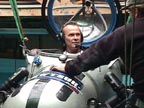
|
Bruce Cowden prepares to do
his first dive during the DeepWorker training at
the Monterey Bay Aquarium Research Institute in
Moss Landing, CA. (Photo: Grays Reef
NMS)
|
|
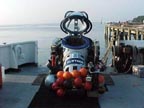
|
DeepWorker 2000 on the back
deck of the NOAA Ship Ferrel awaiting a departure
time to Gray's Reef. (Photo: Grays Reef
NMS)
|
|
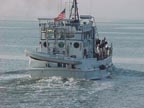
|
Gray's Reef research vessel
Jane Yarn departs from Priest Landing Dock to head
out to Gray's Reef National Marine Sanctuary as a
support vessel during Sustainable Seas. Gray's Reef
is located approximately 17 nautical miles off of
Sapelo Island, one of Georgia's many barrier
islands. (Photo: Grays Reef NMS)
|
|
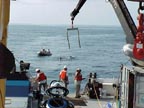
|
First deployment of the
DeepWorker at Gray's Reef. All pilots needed to
undergo check out dives in the field. The
Deepworker is being detached from the towline to
prepare for its descent. (Photo: Grays Reef
NMS)
|
|
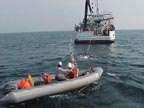
|
NOAA Ship Ferrel getting in
position to recover the DeepWorker. The recovery
and deployment requires a coordinated effort by the
Captain and the deck crew. (Photo: Grays Reef
NMS)
|
|
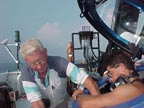
|
Laddie Akins, Director of
REEF (Reef Environmental Education Foundation)
prepares for deployment. Laddie's mission at Gray's
Reef was to conduct fish surveys and explore deep
reefs of the Georgia coast. (Photo: Grays Reef
NMS)
|
|

|
Laddie Akins, inside the
Deepworker during a night dive at Gray's Reef,
recorded observations of thousands of scad that
were attracted by the lights of the sub. (Photo:
Grays Reef NMS)
|
|
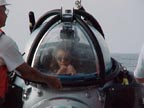
|
Alex Score, Gray's Reef
Information Coordinator, is waiting anxiously to
open the hatch of the sub after a three hour long
dive at Gray's Reef. The temperatures in the sub
can exceed 95°F during a summer day. (Photo:
Grays Reef NMS)
|
|

|
Cathy Sakas, Gray's Reef
Marine educator, was exuberant during her night
dive. Her mission was to explore bioluminescence
activity and describe the transition from diurnal
too crepuscular to nocturnal (day to dusk to night)
activity at Gray's Reef. (Photo: Grays Reef
NMS)
|
|
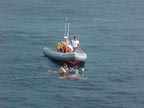
|
A chase boat communicates
with DeepWorker during the entire dive and obtains
vital life support records. The "swimmer" in the
chase boat attaches the towline for the NOAA
Ferrel's complete recovery operations. (Photo:
Grays Reef NMS)
|
|

|
Gray's Reef is made up of
sandstone outcroppings that are covered by colorful
sponges, soft corals, and tunicates, which in turn
attract over 150 species of fish, sea turtles,
dolphins and whales. (Photo: Grays Reef
NMS)
|
|

|
Gray's Reef Ocean Festival
was a great success. Sherry Downs from Savannah
College of Arts and Design created a great collage
for the Ocean Fest. It depicts Savannah's River
Street as if it were under water with the
DeepWorker and divers. (Photo: Grays Reef
NMS)
|
|
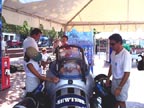
|
Alex Score from Gray's Reef
and Phil Otalora from DOER helped kids gather along
the DeepWorker demo for a turn to sit inside and
feel like a real "aquanaut". (Photo: Grays Reef
NMS)
|
|
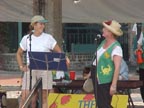
|
Cathy Sakas, Gray's Reef
Marine Educator and SSE pilot, joined in with the
"Crabettes" to sing a song during the Ocean Fest.
(Photo: Grays Reef NMS)
|
|
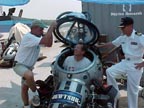
|
Congressman Jack Kingston
from Georgia's First Congressional District and his
son John joined us for a tour. They tried the subs
on for size and toured the ship courtesy of the
FERREL's Commanding Officer, Paul Moen. (Photo:
Grays Reef NMS)
|
|
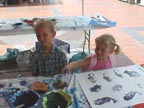
|
Kids art table at the
Oceanfest on River Street. Oceanfest was held on
August 1st, which turned out to be the hottest day
of the year. Despite the 120 degrees heat index,
approximately 2000 people turned out for the event.
(Photo: Grays Reef NMS)
|





